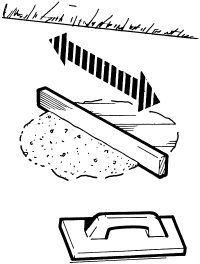How to Fill Potholes in Concrete
Potholes in the streets are bad enough, but potholes in your driveway are worse. However, although you can't do much about problems with public roads, with just a little time and effort you can keep your driveway pothole free.
Tools:
- safety goggles
- cold chisel
- sledgehammer
- stiff broom
- garden hose
- sponge
- sturdy wheelbarrow
- shovel
- stiff paintbrush
- trowel
- 2 × 4 long enough to extend completely over patch area
- wood cement float
- push broom
Materials:
- ready-mix concrete mix (choose sand mix for small holes, gravel mix for large or deep holes)
- liquid concrete bonding agent
- plastic dropcloth
- weights
Time: about 1 day for a good-sized hole, plus a few minutes several times each day during the curing periodBegin the project by removing all the loose pieces of concrete from the hole. Wearing safety goggles, use a cold chisel and a sledgehammer to chop out the crumbling concrete and cut down to sound concrete, roughening the interior surface of the hole. Angle the chisel to undercut the edges of the hole, so that the hole is wider across the bottom than it is across the top. Remove large chunks of broken concrete and sweep out the hole with a stiff broom; flush it thoroughly with water from a garden hose. Then remove standing water with a sponge.Mix ready-mix concrete according to the manufacturer's instructions; use sand mix for small holes and gravel mix for large or deep ones. Pour the dry mix into a sturdy wheelbarrow and add water; mix the concrete thoroughly with a shovel.When the concrete is ready to use, quickly pour liquid concrete bonding agent into the hole. Following the manufacturer's instructions and working quickly, spread the bonding agent evenly over the entire inside surface of the hole with a stiff paintbrush; be sure to coat the undercut corners completely. Clean the paintbrush immediately with water.Fill the prepared hole before the bonding agent dries. Shovel concrete into the hole and trowel it into place, pressing firmly to pack the opening completely full. Mound the surface of the patch slightly above the level of the surrounding concrete and then tamp it firmly down with the back of the shovel. If necessary, add more concrete and tamp again to pack the hole densely.
Advertisement
To level the patch, set a 2 × 4 on edge across the filled hole. You'll need a helper at this point if the patch is a large one. Starting at one end of the filled hole, draw the 2 × 4 in zigzags over the new concrete, pushing and pulling alternately with your helper, one person at each end of the 2 × 4. The smoothed-over patch will have a film of water on its surface.
Let the concrete set for about 45 minutes to 1 hour. When the surface of the concrete is no longer filmed with water, smooth the patch again with a wood cement float. Continue smoothing, using long, even sweeps with the float, until the surface of the patch is filmed with water again.
If desired, finish the surface of the patch with a push broom. Let the patch set after the second float-smoothing until the film of surface water disappears. Then, starting on the old concrete beyond the patch, move the head of the push broom steadily over the filled-in hole and onto the old concrete again.
Let the concrete set until the film of surface water left by the final smoothing has been absorbed. Cover the patch area with a plastic dropcloth, weighted at the edges if necessary to hold it in place. Be careful not to set the weights on the new concrete. Let the patch cure for about a week before walking on it. Several times each day during the curing period, remove the plastic and spray the patched area with the fine spray of a garden hose; recover the patch and reweight the plastic sheet to hold it in place.
For further tips and instructions on how to fix things around the house:
- Home-Repair Safety Tips: Doing the job yourself doesn't save you money if you end up in the emergency room. Read these tips to make sure you work smart when doing home repairs.
- Home-Repair Tool Basics: Does your tool box have what it takes? Learn what tools you're likely to be looking for when making repairs around the house.
